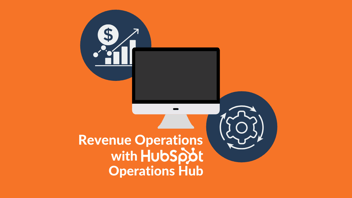
In today’s fast-paced and ever-changing business environment, companies need to continuously update their processes and strategies to remain competitive. Two methodologies that have gained and maintained popularity in recent years are revenue operations (RevOps) and inbound marketing. Both RevOps and inbound aim to optimize revenue generation for businesses, but they approach this goal from different angles. In this article, we’ll explore the similarities and differences between RevOps and inbound and how you can use both to improve processes and enhance alignment among departments.
What is RevOps?
RevOps is a business strategy that aims to streamline all revenue-generating operations across an organization. It brings together sales, marketing, and customer success teams to create a cohesive and integrated approach to revenue generation. As a data-driven approach, RevOps focuses on optimizing processes, reducing friction, and increasing efficiency to maximize revenue.
What is the inbound methodology?
Inbound marketing, as coined by HubSpot, is a marketing methodology that focuses on attracting, engaging, and delighting customers through relevant and helpful content. It is a customer-centric approach that aims to build trust, establish authority, and create long-term relationships with customers. Inbound is based on the idea that customers today have more control over their buying journey, and businesses need to adapt to this new reality by creating content that addresses their customers’ needs and pain points.
Similarities Between RevOps and Inbound
RevOps and inbound marketing have some aspects in common, including
Focus on the Customer
Both methodologies use customer-focused strategies, aiming to create seamless customer experiences that build trust and establish long-term relationships.
Data-Driven Approach
Both RevOps and inbound marketing rely heavily on data collection and analysis, compiling data from various sources to optimize processes and strategies.
Collaborative Approach
Both methodologies require collaboration and alignment among teams within an organization, recognizing that revenue generation is a team effort.
Continuous Improvement
Both RevOps and inbound marketing emphasize the importance of continuous improvement and the ability to adapt quickly to market changes. As a result, both monitor the effectiveness of their strategies and rely on data to make adjustments as necessary.
Use of Technology
Inbound marketing and RevOps both use technology to optimize processes and strategies. They use various tools and platforms to collect and analyze data, automate processes, and improve the customer experience. They value the importance of staying up to date on the latest technologies to remain competitive.
Differences Between RevOps and Inbound Marketing
Despite their similarities, RevOps and inbound marketing approach revenue generation from different angles. Here are some key differences between the two:
Scope
RevOps is a broader approach that encompasses all revenue-generating operations across an organization. It brings together sales, marketing, and customer success teams to create a cohesive revenue generation strategy. In contrast, inbound focuses specifically on marketing and how to attract, engage, and delight customers through relevant and helpful content. The alignment often seen between marketing, sales, and customer service with an inbound approach is more about messaging than common goals and processes.
Focus
RevOps focuses on optimizing processes and reducing friction to maximize revenue generation. It is a tactical approach that aims to increase internal efficiency and effectiveness. By contrast, inbound marketing is a more strategic approach that aims to build long-term relationships with customers by creating content that addresses customers’ needs.
Metrics
While both are highly data focused, RevOps focuses on revenue-related metrics such as customer acquisition cost, lifetime value, and conversion rates. It measures the effectiveness of its strategies and processes based on their impact on these metrics. In contrast, inbound focuses on engagement-related metrics such as website traffic, time on page, and social media engagement. It measures the effectiveness of its strategic content based on their impact on these metrics.
Using RevOps and Inbound Marketing Together
RevOps and inbound marketing are two approaches that aim to optimize revenue generation. While they share some commonalities, they approach revenue generation in different ways. Combining inbound and RevOps can create a powerful revenue generation strategy that unites all departments towards a common goal of delivering a seamless customer experience. Here are some ways businesses can use these methodologies to improve their processes:
Use Inbound to Attract & Engage Potential Customers
By creating valuable content that addresses customers’ needs and helps solve their problems, businesses can attract potential customers to their websites and engage them in conversation. Inbound marketing can help businesses build trust and authority in their industry, which can lead to increased conversions and customer loyalty.
Use RevOps to Streamline the Sales Process
Once potential customers are engaged, businesses can use RevOps to streamline the sales process and reduce friction. By optimizing sales processes and creating a cohesive approach to revenue generation, businesses can improve their conversion rates and reduce customer churn.
Use RevOps to Align All Departments Towards a Common Goal
RevOps can help businesses create alignment among sales, marketing, and customer success teams, ensuring everyone is working towards a common goal of delivering a seamless customer experience. By breaking down the silos and creating a cohesive approach to revenue generation, businesses can improve customer satisfaction and retention.
Use Inbound to Create Long-Term Relationships with Customers
Inbound marketing can help businesses create long-term relationships with customers by providing valuable content that addresses their evolving needs and pain points. By focusing on the customer’s journey and creating a personalized experience, businesses can improve customer loyalty and increate customer lifetime value.
A Powerful Combination
Combining inbound marketing and RevOps can create a powerful revenue generation strategy that aligns all departments towards a common goal. By using inbound to attract and engage potential customers and RevOps to streamline processes and align teams, businesses can create long-term strategies that reduce internal friction and enhance the customer experience.


